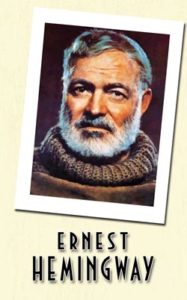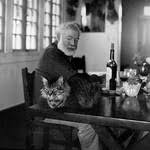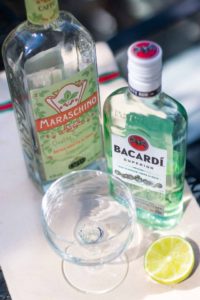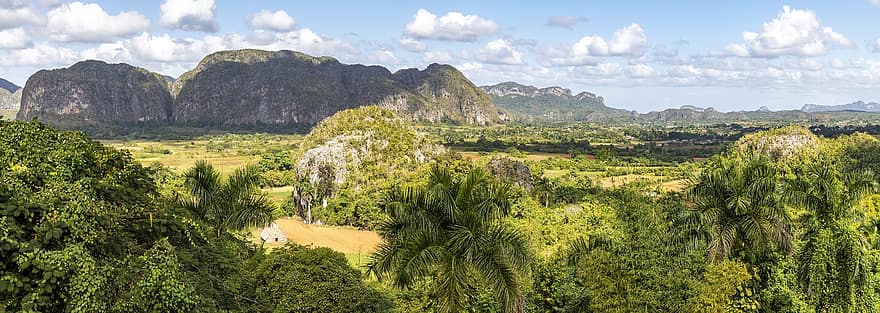ERNEST HEMINGWAY “DAIQUIRI”, THE FAMOUS U.S. WRITER DRINKING HABITS. PHOTOS.
Hemingway is one of those legends whose name we all know, but most of us don’t know all that much about him.
According to drink connoisseurs Ernest Hemingway used to say about visiting Cuba “Don’t bother with churches, government buildings or city squares. If you want to know about a culture, spend a night in its bars.”
Hemingway did love to drink and while he was a writer, “in moderation” wasn’t part of his vocabulary, especially when it came to rum. He was fond of daiquiris, a classic three-ingredient cocktail made with rum, lime juice, and sugar syrup.
But apparently, Hemingway didn’t like the sugar syrup component, and the Hemingway Daiquiri was born at El Floridita bar in Havana, which William Grimes called “a close contender with Harry’s New York Bar in Paris for the title of the most famous bar in the world,” where Hemingway liked to drink.
Hemingway would drink up to a dozen of these daiquiris at one sitting, made with Bacardi white rum, fresh lime, and grapefruit juice, and six drops of maraschino liqueur blended with ice and served in large goblets.
The Hemingway Daiquiri evolved to hew closer to a Daiquiri, served up in a chilled coupe glass, which is just fine with me. Maraschino is a clear, sweet liqueur made from cherries and it’s nice to have on hand to liven up a bowl of summer berries or to spike fruits like peaches and plums before using them in a pie, shortcake, or crisp. But it’s also worth stocking in your bar for making this drink, as well as other classic cocktails, such as The Last Word and the Martinez.
A prolific drinker, Hemingway likely had a number of cocktails named after him. Most had little in common with the legendary writer, but to connect a concoction with the original Most Interesting Man In The World was a good way to sell cocktails.
We don’t know if Hemingway ever drank his namesake cocktail at El Floridita. One of Hemingway’s go-to watering holes in Havana created the cocktail to appeal to casual drinkers and leverage the name of one of its most famous patrons. That’s because no one in his or her right mind would want to consume Hemingway’s preferred drink, the Papa Doble.
As the story goes, Hemingway, looking for a bathroom, popped into El Floridita. There, he saw the bartender mix a batch of frozen daiquiris. Never one to leave an unattended beverage to its own devices, Hemingway picked up the drink and tried it.
After a few tastes, he was said to have told the bartender, “That’s good, but I’d prefer it without the sugar…and double the rum.”
“Always do sober what you said you’d do drunk. That will teach you to keep your mouth shut.” he used to say. Hence, the drink’s name: “Papa” was Hemingway’s nickname in Havana, while “doble” indicates his preferred octane.
While a legend in drinking culture, Hemingway seemed to have terrible taste in cocktails. His favorite drinks seemed to follow a blueprint to consume the largest amount of alcohol in the least time.
That’s evident in the Papa Doble. It’s four ounces of rum with only a splash of lime, blended so cold that it couldn’t be tasted going down.
So, to create a “Hemingway Daiquiri” for the public, El Floridita had to get a bit creative. The recipe, in Hemingway’s own words: “Pour one jigger absinthe into a Champagne glass. Add iced Champagne until it attains the proper opalescent milkiness. Drink three to five of these slowly.”
SERVINGS
2 ounces white rum
3/4 ounce freshly squeezed lime juice
1/2 ounce freshly squeezed grapefruit juice
1/2 ounce maraschino liqueur
lime wheel
Add the rum, lime, and grapefruits juices, and maraschino to a cocktail shaker. Fill with ice and shake until well-chilled, about 15 seconds.
Strain into a chilled coupe glass. Garnish with a lime wheel.
Not to be solely remembered as a drinker for telling bartenders to “double the booze,” Hemingway has at least one published cocktail of his own. He gave it the same title as his nonfiction tome on bullfighting, ‘Death in the Afternoon’. It was published in the 1935 cocktail book So Red the Nose, or Breath in the Afternoon, a collection of cocktail recipes from famous authors.
ERNEST HEMINGWAY “DAIQUIRI”, EL FAMOSO ESCRITOR DE LOS EE. UU HABITOS COMO TOMADOR. FOTOS.
Hemingway es una de esas leyendas cuyo nombre todos conocemos, pero la mayoría de nosotros no sabemos mucho sobre él.
Según los conocedores de la bebida, Ernest Hemingway solía decir sobre una visita a Cuba: “No te preocupes por las iglesias, los edificios gubernamentales o las plazas de las ciudades. Si quieres conocer una cultura, pasa una noche en sus bares ”.
A Hemingway le encantaba beber y, aunque era escritor, “con moderación” no formaba parte de su vocabulario, especialmente cuando se trataba de ron. Le gustaban los daiquiris, un cóctel clásico de tres ingredientes elaborado con ron, jugo de limón y jarabe de azúcar.
Pero aparentemente, a Hemingway no le gustó el componente de jarabe de azúcar, y el Hemingway Daiquiri nació en el bar El Floridita en La Habana, que William Grimes llamó “un competidor cercano con Harry’s New York Bar en París por el título del bar más famoso de el mundo ”, donde a Hemingway le gustaba beber.
Hemingway bebería hasta una docena de estos daiquiris de una sola vez, hechos con ron blanco Bacardí, lima fresca y jugo de toronja, y seis gotas de licor de marrasquino mezclado con hielo y servido en copas grandes.
El Hemingway Daiquiri evolucionó para acercarse más a un Daiquiri, servido en un vaso de cupé frío, lo cual está bien para mí. El marrasquino es un licor dulce y claro hecho de cerezas y es bueno tenerlo a mano para darle vida a un tazón de bayas de verano o para espolvorear frutas como melocotones y ciruelas antes de usarlas en una tarta, tarta o crujiente. Pero también vale la pena tenerlo en tu bar para hacer esta bebida, así como otros cócteles clásicos, como The Last Word y el Martinez.
Un bebedor prolífico, Hemingway probablemente tenía varios cócteles con su nombre. La mayoría tenía poco en común con el legendario escritor, pero conectar un brebaje con el Hombre más interesante del mundo original era una buena forma de vender cócteles.
No sabemos si Hemingway alguna vez tomó su cóctel homónimo en El Floridita. Uno de los abrevaderos de Hemingway en La Habana creó el cóctel para atraer a los bebedores ocasionales y aprovechar el nombre de uno de sus clientes más famosos. Eso es porque nadie en su sano juicio querría consumir la bebida preferida de Hemingway, el Papa Doble.
Según cuenta la historia, Hemingway, en busca de un baño, apareció en El Floridita. Allí, vio al camarero mezclar un lote de daiquiris congelados. Hemingway, que nunca dejó una bebida desatendida por sí sola, tomó la bebida y la probó.
Después de algunas degustaciones, se dice que le dijo al camarero: “Está bien, pero lo preferiría sin azúcar … y con el doble de ron”.
“Haz siempre sobrio lo que dijiste que harías borracho. Eso te enseñará a mantener tu boca cerrada.” El solía decir. De ahí el nombre de la bebida: “Papá” era el apodo de Hemingway en La Habana, mientras que “doble” indica su octanaje preferido.
Si bien era una leyenda en la cultura de la bebida, Hemingway parecía tener un gusto terrible en los cócteles. Sus bebidas favoritas parecían seguir un plan para consumir la mayor cantidad de alcohol en el menor tiempo.
Eso es evidente en el Papa Doble. Son cuatro onzas de ron con solo un chorrito de lima, mezclado tan frío que no se puede saborear.
Entonces, para crear un “Daiquiri Hemingway” para el público, El Floridita tuvo que ser un poco creativo. La receta, en las propias palabras de Hemingway: “Vierta un jigger de absenta en una copa de champán. Agregue Champagne helado hasta que adquiera la lechosidad opalescente adecuada. Bebe de tres a cinco de estos lentamente “.
PORCIONES
2 onzas de ron blanco
3/4 onza de jugo de limón recién exprimido
1/2 onza de jugo de toronja recién exprimido
1/2 onza de licor de marrasquino
rueda de cal
Agregue los jugos de ron, lima y toronjas, y marrasquino a una coctelera. Rellene con hielo y agite hasta que esté bien frío, unos 15 segundos.
Colar en un vaso cupé frío. Adornalo con una rondája de limón.
Para no ser recordado únicamente como un bebedor por decirle a los camareros que “dupliquen la bebida”, Hemingway tiene al menos un cóctel publicado. Le dio el mismo título que su tomo de no ficción sobre tauromaquia, ‘Muerte en la tarde’. Fue publicado en el libro de cócteles de 1935 ‘So Red the Nose’, o ‘Breath in the Afternoon’, una colección de recetas de cócteles de autores famosos.
Agencies/ WineEnthusiast / Dylan Garret/ David Lebovitz/ Extractos/ Excerpts/ Internet Photos/ Arnoldo Varona/ VIDEOS/PHOTOS>LAHISTORIADECUBA
THE CUBAN HISTORY, HOLLYWOOD.












